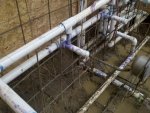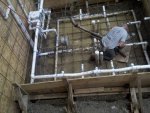Long time lurker new poster and I'm admittedly stumped.
-Gunite Spa with diamond Brite was leaking through the plaster, a leak detection company AnB puddy'd the cracks helping some.
-I remove all DB and notice 4 minor cracks from the beam to to the floor
-I also notice the gunite is crumbling in a few spots when removing the plaster
- Large air pockets all along the hot tub
- pictures showed that during gunite application there were puddles of water on the floor (is that normal)
-Also shows one thin layer of wire mesh laid
The PB has a reputation in the area for BAD work, what is the best method of repair long term? I'd like to fix it 100% before applying the new tile n DB.
Thanks all
-Gunite Spa with diamond Brite was leaking through the plaster, a leak detection company AnB puddy'd the cracks helping some.
-I remove all DB and notice 4 minor cracks from the beam to to the floor
-I also notice the gunite is crumbling in a few spots when removing the plaster
- Large air pockets all along the hot tub
- pictures showed that during gunite application there were puddles of water on the floor (is that normal)
-Also shows one thin layer of wire mesh laid
The PB has a reputation in the area for BAD work, what is the best method of repair long term? I'd like to fix it 100% before applying the new tile n DB.
Thanks all



